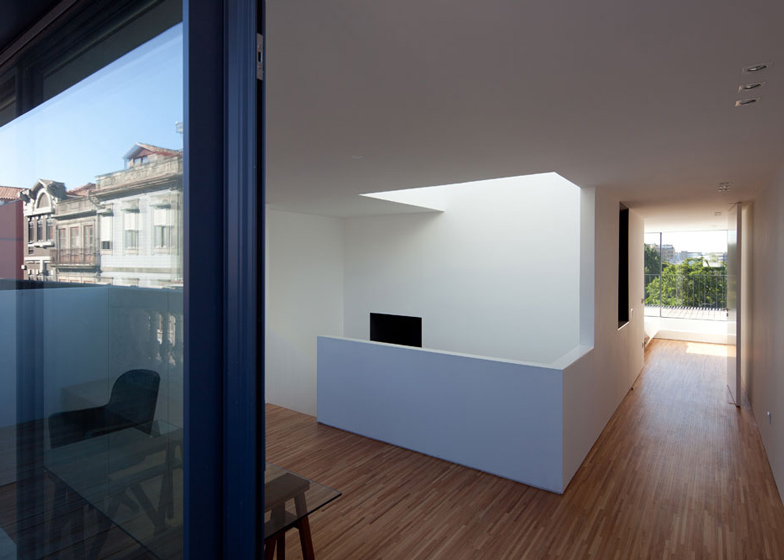Trios of windows and a new lightwell help to bring daylight through the clean white interiors of this renovated townhouse in Porto by local studio Pablo Pita Architects (photos by José Campos + slideshow).
Pablo Rebelo and Pedro Pita of Pablo Pita Architects added an extra storey to the nineteenth-century residence, known as Casa da Maternidade, to create enough room to house a family.
The architects extended the original staircase, but rather than following its existing back-and-forth arrangement, they wrapped the extra stairs along the edges of two walls to open up a double-height space in between.
A skylight was then added overhead to transform the space into a generous lightwell.
"The lack of an expressive skylight in the original structure defines the approach," said the architects.
"A new scale is set in the stair core, overlapping this new vertical walkthrough that runs along the existing house, achieving new see-throughs and different spatial relations between all the floors," they added.
The newly added second floor accommodates a master bedroom and a study, both of which open out to rooftop balconies. There's also an en suite bathroom encased in glass.
Two smaller bedrooms and a bathroom lined with turquoise mosaic tiles occupy the floor below, while an open-plan living and dining room spans the ground floor and leads out to a terrace and garden.
Photography is by José Campos.
Here's a project description from Pablo Pita Architects:
Maternidade
Maternidade House is a single-family dwelling set in a 19th century refurbished house. An example directly restricted to an existing context where the dwelling return to its basis. Adapted to the contemporary needs and standards, the intervention respects its inner scale and typologic scheme.
Conceptually it reinterprets the nuclear core of this type of model, acknowledging the importance of light. The lack of an expressive skylight in the original structure defines the new approach.
A new scale is set in the stair core, overlapping this new vertical walkthrough that runs along the existing house, achieving new see-throughs and different spatial relations between all the floors.
The building is a typical late 19th century Porto house set in the city downtown. It is located in one of biggest city blocks, defined by large gardens in its interior, a bourgeois manor and an early last century maternity. The house itself was a two-storey middle-class example, with little ornamentation and highly modified through time.
The intervention aims to adapt this typical Porto dwelling typology to the daily contemporary routines. This is set from a depuration exercise, developing mainly the stair core, in order to achieve a unifying element that could relate all these different spaces.
The stairs and its light were a recurrent theme in such a narrow and long type of housing. The rooms respect its original scale, and a third floor is added considering the block outline.
The ground floor is the social level, gathering parking, kitchen and living-room, and relating it to the garden located in the interior of the block. In the highest level a guest floor is set with a wide perspective of its surroundings.
Project name: Casa da Maternidade
Architecture: Pablo Rebelo, Pedro Pita
Consultants: ALFAengenharia, PROQUALITYengenharia, Ricardo Ferreira da Silva
Constructor: F. Moreira da Silva & Filhos, Lda
Location: Porto, Portugal
Date: 2013









